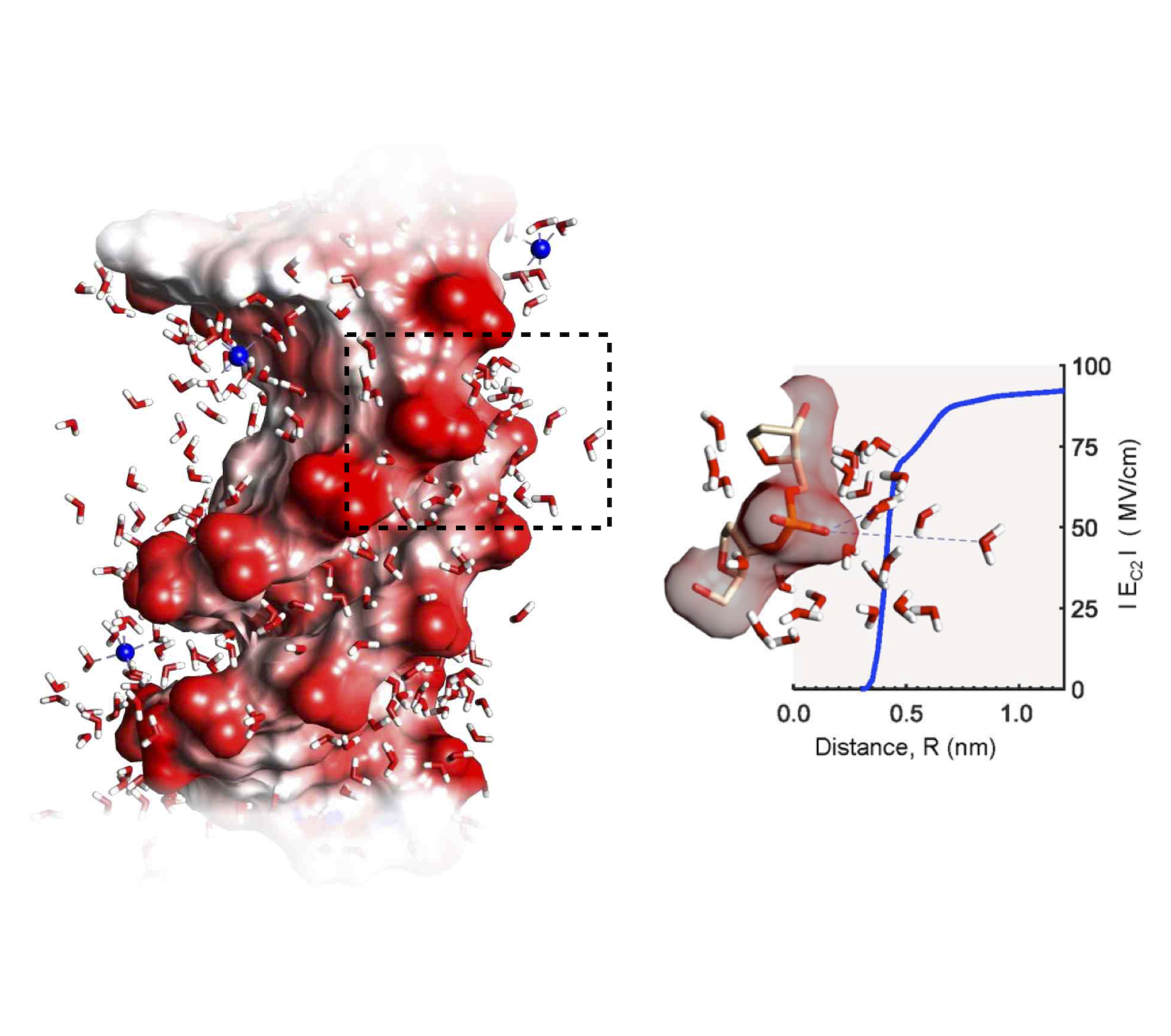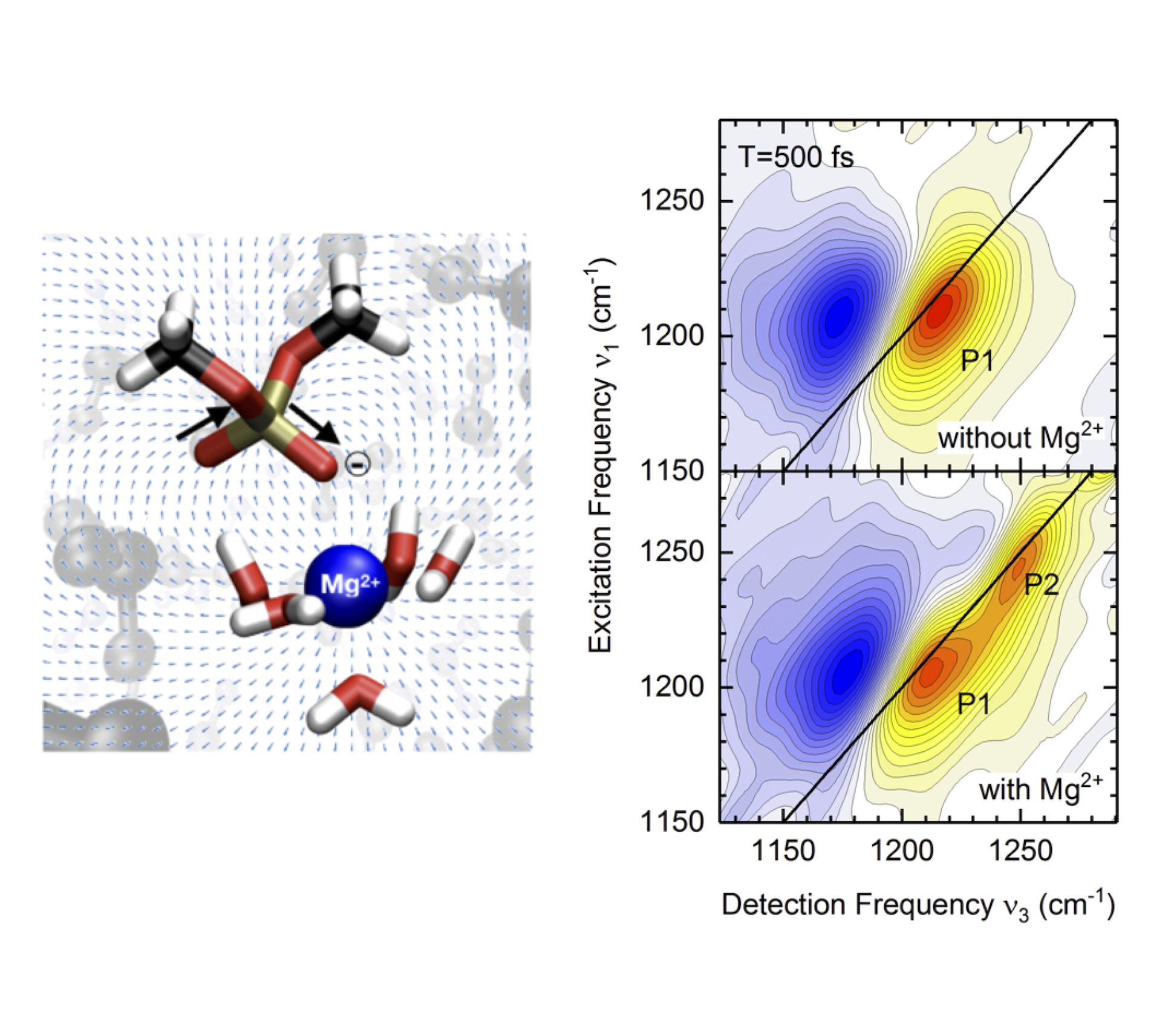Electrostatics at biological interfaces
Quantification of non-covalent interactions at biological interfaces:
Hydration of polar and ionic molecular structures is characterized by the interplay of long-range electric, specific short-range and inductive many body interactions. Biological interfaces such as phospholipid containing cell membranes or the surfaces of DNA and RNA contain negatively charged phosphate groups that form hydrogen bonds with the first water shell and are polarized by fluctuating electric fields arising from the surrounding water molecules. Biological interfaces thus represent a complex many-body problem which is understood only in part. In particular, the effective range of electric forces, their strength and fluctuation amplitudes at the phosphate-water interface have remained highly controversial.
We have established helix backbone vibrations of DNA [1], double helical RNA [2,3] and folded transfer RNA (tRNA) [4] as noninvasive and dynamical real time probes that provide interfacial sensitivity for interactions with the hydration shell. The characterization of biomolecular solvation dynamics was facilitated in a joint theoretical-experimental collaboration that combines microscopic quantum-classical molecular dynamics descriptions of the interface and findings from two-dimensional infrared (2D-IR) spectroscopy measurements of backbone phosphate (PO)2- vibrations where the latter impose stringent boundary conditions on the theoretical description. In particular, we use the molecular response of the asymmetric (PO)2- stretching vibrations in the 900-1300 cm-1 range to obtain surface-sensitive insight. Due to the high polarizability, (PO)2- groups exhibit outstanding sensitivity with respect to the local environment. Our developed theoretical protocols relying on ab initio based fragment molecular orbital method provided quantitative insight into the interactions governing the spectroscopic observables at the phosphate water interface [5,6].
Key Publications:
-
T. Siebert, B. Guchhait, Y. Liu, B. P. Fingerhut, and T. Elsaesser, "Range, Magnitude and Ultrafast Dynamics of Electric Fields at the Hydrated DNA Surface." J. Phys. Chem. Lett. 7, 3131–3136 (2016).
-
E. M. Bruening, J. Schauss, T. Siebert, B. P. Fingerhut, and T. Elsaesser, "Vibrational Dynamics and Couplings of the Hydrated RNA Backbone: A Two-Dimensional Infrared Study." J. Phys. Chem. Lett. 9, 583-587 (2018).
-
A. Kundu, J. Schauss, B. P. Fingerhut, and T. Elsaesser, "Change of Hydration Patterns upon RNA Melting Probed by Excitations of Phosphate Backbone Vibrations." J. Phys. Chem. B 124, 2132-2138 (2020).
-
J. Schauss, A. Kundu, B. P. Fingerhut, and T. Elsaesser, "Magnesium Contact Ions Stabilize the Tertiary Structure of Transfer RNA: Electrostatics Mapped by Two-Dimensional Infrared Spectra and Theoretical Simulations." J. Phys. Chem. B 125, 740-747 (2021).
-
R. Costard, T. Tyborski, and B. P. Fingerhut, "Anharmonicities and coherent vibrational dynamics of phosphate ions in bulk H2O." Phys. Chem. Chem. Phys. 17, 29906-17 (2015).
-
B. P. Fingerhut, R. Costard, and T. Elsaesser, "Predominance of short range Coulomb forces in phosphate-water interactions - a theoretical analysis." J. Chem. Phys. 145, 115101 (2016).


